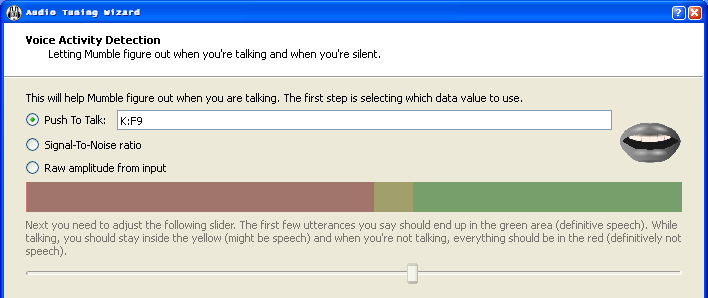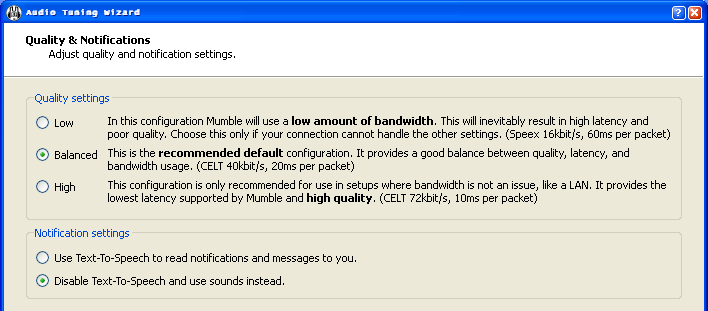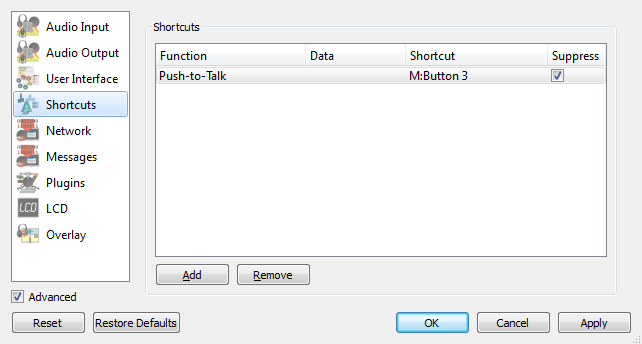More actions
Karasu zed (talk | contribs) Added information regarding Public and Combat Lounges, and guide to announce fleets in Combat Lounge. |
|||
| Line 249: | Line 249: | ||
== Troubleshooting == | == Troubleshooting == | ||
The Mumble FAQ on the Mumble homepage - [http://mumble.sourceforge.net/FAQ http://mumble.sourceforge.net/FAQ] - has a lot of useful information, and also has a section on Common Problems and Resolutions which may be helpful. | |||
=== A referral was returned from the server. === | === A referral was returned from the server. === | ||
Revision as of 20:35, 20 March 2011
Why is it useful?
Mumble is mostly used in two situations: PvP and Classes. In PvP it is very useful because, for example, it is faster to call out a primary target than to type it, especially with PvP related lag. In classes it is great as well because we do not want our poor instructors getting Carpal Tunnel Syndrome from typing everything. In effect, it is just a lot easier and faster than typing.
Very quick guide
- Download mumble from http://mumble.sourceforge.net/ (now on version 1.2.3).
- Install and set it up (create your own certificate, etc)
- Start the client and Server>Connect>Add New...
- Servername: Eve University
- Address: mumble.eveuniversity.org
- Port: 64738 (Default)
- Username: <Your Forum Username, i.e: your character name with nothing either side>
- Connect (you can ignore the certificate warning - this will be fixed later).
- When prompted for your password, use your forum password!
- There is no six!
- You should automatically be dropped in the "Public Lounge" channel.
- Talk.
- Restart EVE client if you want overlay to work.
Setting up Mumble
Audio Tuning Wizard
When you run Mumble the first time, an Audio Tuning Wizard is presented to you. If you skip or miss it on the first run you can retake the wizard by clicking Configure > Audio Wizard. It is recommended you go through it carefully, since setting up Mumble correctly will make your and everyone else's life much easier (going through the Audio Tuning Wizard properly will also normalise everyone's voices, such that everyone will sound the same volume regardless of how they have their microphone set up). However there are two things I would like to highlight:
Push-to-talk
When you reach a screen that looks like the one above select the top radio button, click on the box on the same line and press the key you you want to use as the push-to-talk key.This is your normal push-to-talk key; for certain Fleet roles you may need more than one (see the comments in the Fleet channels), but for general E-UNI activity one is sufficient.
Text-to-speech
When you reach a screen that looks like the one above I recommend you disable the text to speech notifications.
Connecting to the EVE University Server
Once Mumble is all set up and you have run through the Audio Turning Wizard, you will want to connect to the EVE University server.
- Go to Server in the toolbar --> Connect.
- Click the Add New... button in the bottom right.
- Put anything you like in the Label box ("Eve University" seems sensible), the Address box needs to be mumble.eveuniversity.org and the Port needs to be left as default (64738).
- The Username box needs to be your exact E-UNI forum username, which also happens to be your exact character name.
- Click the Connect button.
- n/a
- The server will reject your connection, and prompt you with a Wrong Password box. You need to use your forum password (i.e. the same password you chose when you registered for our forums) in the box, then click OK.
- You are now connected to the Mumble server, which will have moved you into the Public Lounge channel.
Notifications
In the Configure --> Settings screen you can find Advanced settings checkbox in the bottom left corner. With it checked you can access the Messages settings. From there you can disable popup and sound notifications about events you don't care about.
Other interesting features
- Mouse-over anyone's name and their ingame portrait will pop up.
- Right-click on a channel and select Join Channel to move to that channel (double-click sometimes produces strange behaviour with nested channels).
- If the name of the channel that you are in is italicized, then your push-to-talk button, in addition to talking to the current channel, will also talk to everybody in every other channel that is also italicized. Italicized names denote linked channels (you can only see this if you are currently in a linked channel).
- Click the small yellow |c| button on any channel (or any person) to see comments on that channel (or person). The |c| will go white once you've read it (and go yellow again if it changes). You can set your own comment by right-clicking on your own name.
- You will automatically be moved to the AFK & Idle channel if Mumble detects no activity on your computer for at least 4 hours. Everybody is automatically muted in that channel, so you can also move yourself there if you desire peace and quiet
- You can create your own channels for EVE purposes (in the On-Demand Channels section) or for any non-EVE gaming purposes (in the Non-EVE Gaming section) by right-clicking on the relevant section and choosing Add. These are temporary channels, you will have admin powers and once the last person leaves the channel will disappear.
Overlay
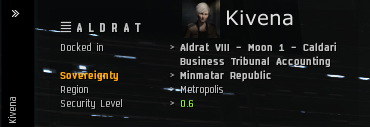
Mumble provides a very handy and customizable overlay. To configure it go to Configure --> Settings --> Overlay option.
Mumble, being the awesome program that it is, shows in this window an example of what the overlay will look like on your current desktop, as well as instructions on how to alter it. One position that works very well is just to the right of the current location name, like the screenshot on the right. You could even put it above the current location, but then - for me at least - it's too small to see easily.
The default setting is for the Overlay to display the name of everyone currently in the channel. As you can imagine, this gets unwieldy very quickly. To change this, right-click on the small example overlay in the window, choose Filter >, and tick Only talking. Also untick Always show yourself, otherwise your name will constantly be displayed on the overlay.
The Edit... option on the right-click menu produces a detailed configuration screen where you can change pretty much anything you like about the overlay: colours, sizes, backgrounds, avatars, etc.
If your overlay is not showing up, you must have started EVE after Mumble. If necessary simply restart EVE.
Overlay Settings File
If you don't want to go through the Overlay settings, or feel like taking the easy way, I have uploaded a settings file here, which will make your overlay look like the one in the screenshot above right.
- Follow the link above to save it to a handy location on your computer.
- Go to the Overlay settings as explained above.
- Click the Load... button near the top, navigate to and select the file, click Open. Click Apply or OK in the bottom of the Settings window.
- You now have a fully functioning overlay!
I'm not sure how this will behave with different resolutions, screen settings or indeed operating systems - it was created on Windows 7 - so if you have any problems with it you can choose the Restore Defaults button in the bottom of the Settings screen to reset the options.
Overlay on Linux
To actually display the overlay over Eve in Linux after you've enabled it in Mumble's settings you need to have Mumble launched first and then run mumble-overlay in front of the wine command that you use to launch Eve. For example:
mumble-overlay wine explorer /desktop=Eve,1600x1200 "C:\Program Files\CCP\EVE\eve.exe"
If you use a WINEPREFIX, then you would insert it after the WINEPREFIX variable like so:
WINEPREFIX=/home/username/bin/wine/wine-eve/ mumble-overlay wine explorer /desktop=Eve,3200x1180 "C:\Program Files\CCP\EVE\eve.exe"
Overlay on Mac
To Enable the overlay goto Preferences and Click overlay top right button. Click the enable overlay tickbox on the top left corner of the window then using the screen display below drag and size the overlay position to a point on a screen that you feel comfortable with. The red spot moves the anchor of the overlay. You can change the size of the name displayed using mouse scroll wheel.
Version 1.2.3
The new 1.2.3 has a working overlay. After dragging the Mumble Icon out of the dmg which mounts after your download to your folder of choice, right click the icon and choose "Show Package Contents" Navigate to the following folder:
Mumble.app/Contents/Resources/MumbleOverlay.pkg
Launch the package and run the installer. Restart mumble and enable your overlay! Launch Eve as normal; no command line is necessary.
One of the great advantages of Mumble over Teamspeak is the ability for squad members and their SC to talk amongst themselves, without clogging up comms for the rest of the fleet - in the Structured fleet channel, ZZ Alpha Fleet. This can be invaluable for bait squads and instructing new members. In order for this to work however, it requires people to be in the right channel and everyone should have their keys set up correctly. For small fleets this can be a bit overly-elaborate, so we also run Semi-structured channels for most fleet operations - fleet channels Alpha to Juliet.
An important note to start off on: if, when you join a channel, the channel name becomes italicized, then your current channel is linked to the other italicized channels, and your normal PTT button you set up during Mumble installation will talk to everybody in every currently italicized channel.
Semi-structured fleet channels
Semi-structured fleet channels - such as contain two channels, the main fleet channel named (e.g.) Delta Squad and a sub-channel name (e.g.) Delta Command. As you probably already realised, if you are in a command position such as SC, WC or a Scout (or the FC tells you to get into command chat), you should join the Command sub-channel, whilst normal fleet members should join the parent Squad channel. This sort of fleet channel is useful for medium sized fleets (e.g. one or two wings).
The two channels are linked, which means the normal PTT talks to both. Therefore fleet members do not need any special PTT key, your normal PTT you set up during Mumble installation talks to everyone in the fleet (yes, even those in Command). If you are in Command, you will need another PTT key that talks only to the current channel. To set that up, go to Configure -> Settings -> Shortcuts, which will pop up a window that looks like this:
Although on yours, you should see only your current push-to-talk key already set up in the Shortcuts window, as you haven't set up any others yet. It's a good idea to check the Suppress box on any shortcuts, as that will prevent other applications from recognising your key and performing unforseen tasks you had not expected (e.g. warp scrambling stargates).
- Click the Add button in the bottom left, which will bring up a new Unassigned shortcut in the window.
- Click the Unassigned word and select Whisper/Shout or Whisper depending on your Mumble version from the drop-down list.
- Click the Empty word next to it, which should cause a (...) button to appear next to that - click that to open a new Whisper Target window.

- Make that new Whisper Target window look like this (i.e. Current channel highlighted), and then click OK.
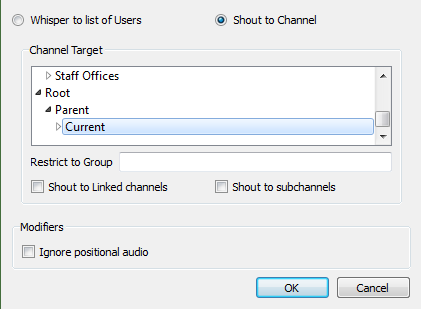
- Finally click the Shortcut column of your new shortcut and press the key you wish to use.
- You now have a Command chat key set up for the semi-structured fleet channels!
Note that it will only talk to Command chat if you yourself are also in Command. If you are in the general fleet channel it will talk to the general fleet ONLY, i.e. not Command.
Fully structured fleet channels
This part of the Mumble setup guide focuses on setting up your key shortcuts for the structured fleet channel, currently named ZZ Alpha Fleet. This is used only really for large scale PvP operations (e.g. multiple wings or fleets), so unless you are expecting to join a huge fleet of hundreds of unistas, you can probably skip this bit for now.
E-UNI fleets will use four distinct "channels" (these are not real channels as such but the concept helps to understand the difference between the actions behind different hotkeys).
- Fleet "Channels":
- Squad Channel (same level), where the squad members can have their internal chat without bothering the rest of the fleet (or even their SC)
- Command Channel (same level) for FC, WC, SC and scouts to discuss between themselves
- Report Channel (upwards), where squad members reports their actions to their SC, e.g. calling points
- Order Channel (downwards), for command staff to give orders to the members below them in the fleet structure i.e. FC to talk to whole fleet, WC to their wing, SC to their squad
In structured fleet channels three different hotkeys are used to establish the channels described above, and creating an ability to talk "up" and "down" the command structure.
Your normal PTT key you set up during Mumble installation acts as the 'same level' shortcut: for squad members it will talk to your "Squad Channel" (but, do take note, NOT your squad commander); for the FC, WCs, SCs and Scouts, it will talk to the the rest of your command on the "Command Channel" (because all of the command channel positions are linked).
Both squad members and command positions will need one more shortcut, and it is different depending on your role.
- For squad members: you will need a Whisper/Shout to Parent shortcut
- For command channel: you will need a Whisper/Shout to Current (including subchannels) shortcut
Whisper/Shout to Parent
Follow the steps in setting up a shortcut in the previous section. When you get to the Whisper Target window, make it look like this (i.e. Parent highlighted, Whisper/shout to subchannels ticked).
It is important the Whisper/Shout to sub-channels is ticked. This is the key that you will use to talk to your Squad Commander (it also talks to the rest of your squad). Note that it will NOT talk to anyone else e.g. FC, Scouts, other squads.
Whisper/Shout to Current
Follow the steps in setting up a shortcut in the previous section. When you get to the Whisper Target window, make it look like this (i.e. Current highlighted, Whisper/Shout to sub-channels ticked).
It is very important that the Whisper to subchannels is ticked. This is the key that you will use to talk to everyone below you in the fleet structure. That is, for FCs it will talk to the whole fleet, for WCs it will talk to your wing, for SCs it will talk to your squad. For Scouts, you should generally not need it, though if you are in the same channel as the FC it will talk to the whole fleet.
Different channels in Different Roles
Now let's show how the key bindings we made link to the channels we mentioned and how they are used in different roles in a Structured fleet:
- FC:
- Push-to-talk => Command channel
- Whisper/Shout to Parent (No use for an FC)
- Whisper/Shout to Current => Order channel (I.e. FC giving orders to whole fleet)
- WC/SC:
- Push-to-talk => Command channel
- Whisper/Shout to Parent (No use for an WC/SC)
- Whisper/Shout to Current => Order channel (I.e. WC/SC giving orders to their wing/squad)
- Other command staff will not hear SC/WC talking to his/her squad/wing on a squad channel. To keep your FC up to date on what the squad/wing is doing SC/WC must remember to inform also the command channel (Push to talk)
- Other command staff will not hear SC/WC talking to his/her squad/wing on a squad channel. To keep your FC up to date on what the squad/wing is doing SC/WC must remember to inform also the command channel (Push to talk)
- Scout:
- Push-to-talk => Command channel
- Whisper/Shout to Parent (No use for a scout)
- Whisper/Shout to Current (No use for a scout, though you could use it to talk to the whole fleet)
- Squad member:
- Push-to-talk => Squad channel (without SC!)
- Squad Commander will not hear squad members talking in squad channel. Use report channel (Shout-to-Parent) if you want your SC to hear you
- Whisper/Shout to Parent => Report channel (own squad including SC)
- Other command staff will not hear reports (e.g. call of points) made by a squad members to their SC using the report channel! SC has to make sure to keep your FC up to date by relaying important bits of information to command channel (using their Push-to-talk key)
- Whisper/Shout to Current => (No use for a squad member)
- Push-to-talk => Squad channel (without SC!)
In short, the structured fleet channels enable great streamlining and filtering of information. This way, fleet commanders can focus on leading the fleet rather than having to process endless streams of information and squad members and their commanders can coordinate more efficiently amongst themselves. On the other hand, all this requires a great deal more communication and discretion in doing so from SC’s to the rest of command.
Channel Properties for the Public and Combat Lounges
Both the Public Lounge and the Combat Lounge are linked on the Mumble server so that both channels can both listen to and speak to each other without having to move yourself between the channels, but there is a restriction on who can be in each channel. Anyone that has a forum account with EVE University's website can access the Mumble server, and the Public Lounge is the equivalent of the E-UNI chat channel as it is open to anybody regardless of membership. Essentially, Mumble users that are not corporation members with EVE University are restricted from entering the Combat Lounge. This is very important regarding communication that needs to follow the Operational Security rules and guidelines, as discussed here: Operational Security.
Safely and Securely Announcing Fleets in Mumble's Combat Lounge Channel
The process to announce a potential fleet in Mumble that is in accordance with the Operational Security rules and guidelines is the following:
- First check that you are in the Combat Lounge channel on the Mumble server, and that you have your Mumble shortcut for semi-structured fleet channels. You can view how to do this here: Semi-Structured Fleet Channels in Mumble
- If you're in the Combat Lounge channel you can use your command channel shortcut to speak to only those in the current channel about potential fleet activity. It's best to do this while avoiding anyone else talking over Mumble, as Public Lounge will not be able to hear your message and may speak over you. So please try to keep the message brief and clear so it has the best chance of getting across effectively to those in the Combat Lounge.
Setting up an EWAR token
If you intend to fly an EWAR Ship make sure to look at this guide by Remric and setup an EWAR token as described there.
Troubleshooting
The Mumble FAQ on the Mumble homepage - http://mumble.sourceforge.net/FAQ - has a lot of useful information, and also has a section on Common Problems and Resolutions which may be helpful.
A referral was returned from the server.
"A referral was returned from the server." error while starting Mumble on Windows Check your system time. Windows certificate check will fail if your clock is some years ahead/behind.
For Windows XP: Install the latest Root Certificate update through Windows Update (it's an optional update) to fix this problem.
For Windows Vista/7: Right-click the Mumble executable, select "Properties", select the "Digital Signature" tab, click "Details" and click "Install certificate".
Installing https://www.startssl.com/certs/ca-bundle.crt to the "Trusted Root Certification Authorities" cert store should also work.
If you compiled Mumble yourself either sign the binary or disable signing.
If you are on windows 7 and this doesn't help you, try this out. Press Start, type MMC and press enter go to File and select Add/Remove Snap-ins in available snap-ins select Certificates and press ADD. you get three options, I personally went with "My User Account"
with that done exit the Snap in management window and double click on the Certificate Icon, then double click on the "Trusted Root Certification Authorities" Right click on the Certificate icon that appears and highlight "all tasks" then click on the Import button.
The import wizard will then ask for the filename of the certificate you want imported. First Save As: https://www.startssl.com/certs/ca-bundle.crt in whatever folder you want then link it to the import tool. follow the wizard's instructions and "Voila" you now should be able to use Mumble

